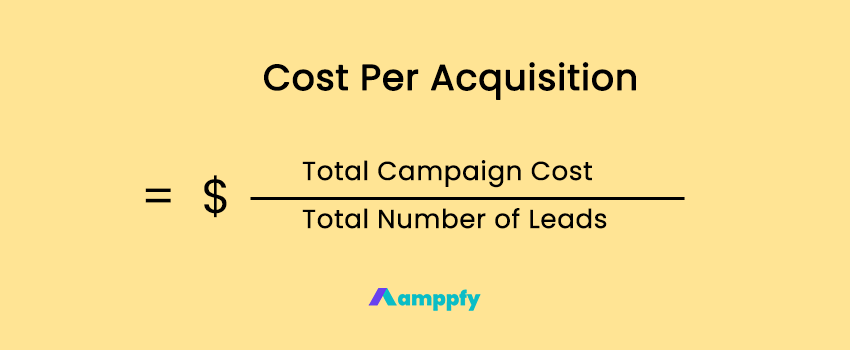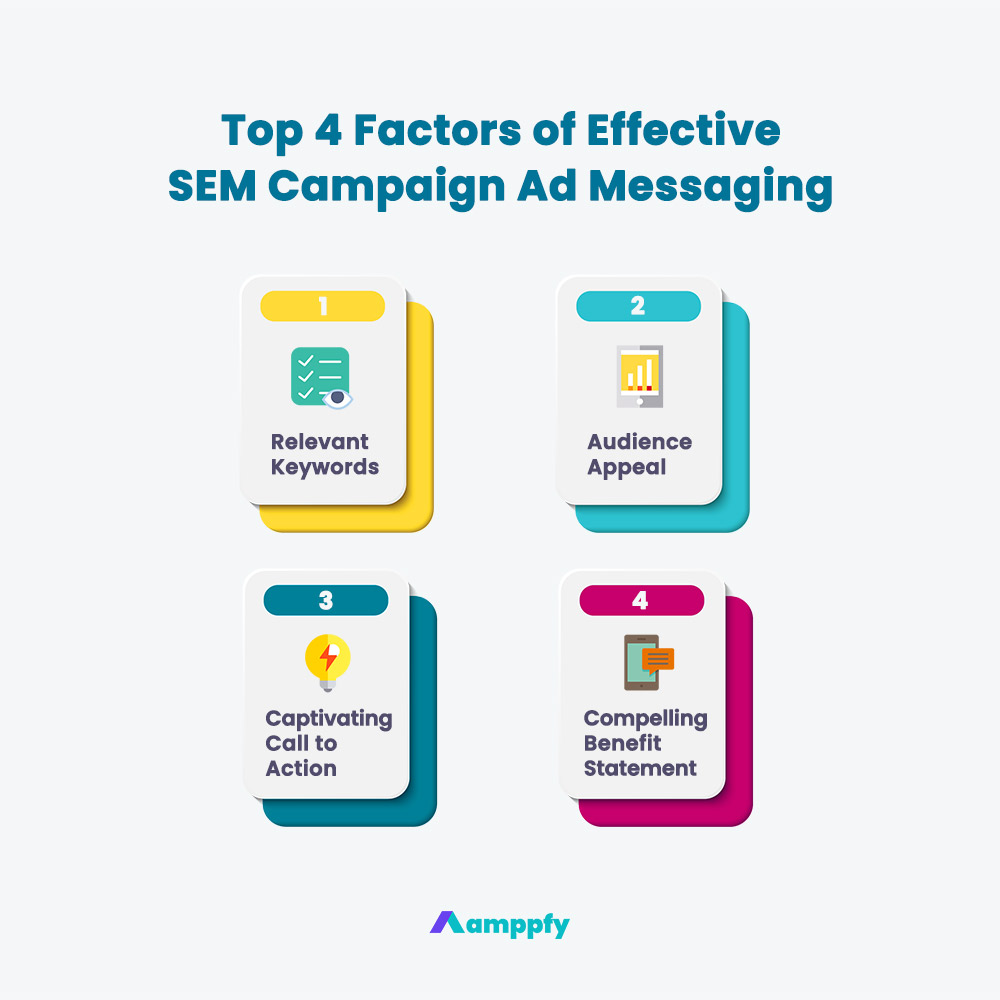Share via:

-
Save
Keywords with high search volume are more likely to have expensive CPC (Cost-Per-Click) or PPC (pay-per-click) rate. Depending on the industry, the cost-per-click rate of an SEM ad campaign ranges from a few pennies to over twenty dollars per single click. Let’s discuss how to control SEM campaign costs to minimize SEM ad spend and increase the conversion rate of a lead or a sale.
Top 12 SEM Marketing Strategies to Cost Control SEM Ads and Maximize Conversion Rate
#1. Define Cost Per Acquisition Parameter in SEM Marketing Campaign
Cost per acquisition, or CPA, is the bidding method that focuses on maximizing conversion rate while reducing ad spend. CPA measures the cost to complete a call-to-action (CTA), such as capturing a lead or closing a sale. Within Google Ads and Microsoft Ads, set an appropriate CPA and define how much marketing budget to allocate towards each acquisition or conversion within an ad campaign.
How to Calculate Cost Per Acquisition in SEM Ads
Cost per acquisition is calculated by the total ad campaign cost divided by the total number of leads converted. The value is a dollar amount representing how much an ad campaign costs to make the conversion happen.

-
Save
#2. Evaluate SEM Marketing Campaign Ad Messaging Performance
Messaging in an SEM ad is critical to a winning paid search campaign. High-performing ad messaging increases ROI or return on investment. Effective ad messaging increases CTR (Click-Through Rate) and drives more opportunities to successfully complete a conversion. Periodically test ad messaging for optimal campaign performance.
Try the Free Google Ads Generator for Ad Descriptions
- 100% Free
- No Account Required
- Available 24/7
Top 4 Factors of Effective SEM Marketing Campaign Ad Messaging

-
Save
- Relevant keywords
- Audience appeal
- Captivating call-to-action
- Compelling benefit statement
Learn more about creating effective SEM ads and campaign messaging.
#3. Improve SEM Marketing Keyword Performance with Advanced Keyword Research Tools
Analytics data is the key to SEM ad campaign’s keyword performance and conversion rate success. Use search engine marketing tools like Semrush to discover profitable keywords. Check for search volume and competitiveness of every keyword periodically. Focus on raising Google Quality Score and click-through rate of keywords within ad content.
Learn more about top SEM keyword research strategies.
4 Criteria of High-Performing SEM Keywords
- Yield high sales volume
- Generate the most clicks
- Create the lowest bounce rate (when a visitor exists a webpage without taking action)
- Lead to the most time spent on the website
- Discover all the best keywords to target and bring traffic to your site through Semrush keyword research tool.
- Audit webpages and suggest ideas to improve SEM performance.
- Uncover all of the keywords and content in competitors’SEM strategies.
- Research competitors to uncover their display ads and SEM marketing campaigns.
- Track hundreds of relevant keywords and their Google CPC pricing on a daily basis.
- Easily research keywords that have search volume relevant to any blog or website.
- Get competitive research on SEM and display ads.
- Does not include social media analytics
#4. Split SEM Marketing Ad Campaign Traffic and A/B Test Landing Pages
Getting visitors to click on an ad is only half the battle. Turning that click into a conversion is the ultimate objective of a successful SEM marketing campaign. So, how to ensure the ad campaign’s landing page effectively converts call-to-action, such as a sale? Use A/B testing.
A/B Testing SEM Marketing Ad Campaign Landing Pages
A/B testing divides traffic from the same ad campaign onto two or more landing pages. Test ad elements such as keywords one at a time to perfect ad messaging and landing page content for maximum conversion results. Monitor how various landing page elements improve the conversion rate. Keep testing and perfecting the ad campaign for better ROI over time.
#5. Simplify Customer Acquisition Conversion Funnel on SEM Marketing Campaign Landing Pages
Improve the conversion rate of websites by simplifying customer acquisition conversion funnels on the SEM ad campaign landing pages. Here are two examples.
Example 1: Optimize E-Commerce Website Checkout Process
For e-commerce websites, the goal is to guide visitors through checkout in as few simple steps as possible to reduce friction. Making an efficient checkout funnel improves user experience and leads to better conversion results. An efficient checkout process has a higher potential to turn ready-to-buy visitors into customers.
Example 2: Optimize B2B Website Form Fill Process
For B2B websites promoting email signups or form fills that involve collecting customer data, make the landing page form brief, simple, and frictionless. Shorter and straightforward form-fills are more likely to convert through an ad campaign.
Try the Free Email Subject Line Generator
- 100% Free
- No Account Required
- Available 24/7
#6. Increase SEM Marketing Campaign Conversion Rate
Conversion rate is the percentage of total sales volume, leads, or other conversion values divided by the total number of visitors. It is one of the most critical key performance metrics in search engine marketing that needs to be tracked closely.
The higher the conversion rate in an SEM marketing campaign, the better the ad performs. Keywords, ad messaging, and landing page optimization all significantly influence ad campaign conversion rates.
3 Key Factors Impacting SEM Marketing Campaign Conversion Rate

-
Save
Key Factor #1: Analyze SEM Keyword Performance
Refer to the analytics data from Google Ads and Microsoft Ads to track and improve the campaign’s performance. Based on the data, refine ad messaging, benefit statements, and call-to-actions.
Key Factor #2: Optimize SEM Ad Messaging with Keyword Research
Use keyword research tools to find, track, monitor, and refine keywords with the lowest CPC and the highest CTR in ad campaign messaging. High-performing keywords uncover unique niche markets and improve conversion rates.
Key Factor #3: Improve SEM Ad Campaign Landing Page efficiency
A/B test different visuals, titles, and CTAs to identify the best landing page content for a high-conversion SEM campaign.
#7. Reduce SEM Marketing Campaign Bounce Rate
Bounce rate is one of the most negative metrics affecting an SEM campaign’s success. When visitors leave a website immediately after clicking on an ad, advertising dollars are wasted, leading to a lost opportunity.
How to Reduce SEM Marketing Campaign Bounce Rate
Other than technical issues or broken links, landing page content is the first to be evaluated. Ambiguous, irrelevant, or misleading landing page content contributes to high bounce rate. What visitors see on the landing page should be consistent with the ad messaging. Focus on concise call-to-actions and highlight the benefits statement. A sales pitch gets clicks but becomes lost marketing dollars when a customer leaves a landing page because of low-quality content.
#8. Target Geolocation Performance in SEM Marketing Campaign
Picking the right location significantly increases the precision of an SEM ad campaign. In Google Ads and Microsoft Ads, update the location option to the appropriate geographical regions the ad should target. Specify the location based on county, state, or city. Then, adjust the campaign bids according to ad performance in different locations. It is a cost-conservative way to push campaigns to the right audience for maximum exposure.
Take Advantage of Location-Specific Keywords in SEM Marketing Campaign Landing Pages
Use location-specific keywords in landing pages like New York City or Los Angeles to better respond to location-specific search queries. Make educated predictions of visitor demographics by researching Google Analytics reports.
Learn more about Google Ads location targeting for SEM campaigns.
#9. Optimize Time on Site Metric for SEM Marketing Campaign
The longer visitors stay on a landing page after clicking through an ad, the more likely they will respond to CTAs.
Examples of SEM Marketing Campaign Landing Page Call to Actions
- Clicking on a link
- Completing a form fill
- Making a purchase
How to Increase Time on Site and Decrease Bounce Rate
More dwelling time on a webpage potentially reduces bounce rate and increases the website’s Google Quality Score rating over time for the SEM ad. How to keep visitors from ditching a landing page too soon? The following are effective metrics to improve visitor time on site.
Top 3 Metrics to Improve Visitor Time on Site

-
Save
- High content engagement
- keyword relevancy
- Creative ad messaging
#10. Customize SEM Marketing Campaign Schedule and Ad Performance
Google Ads and Microsoft Ads allow scheduling customization of the time when SEM campaign ads appear in search results. It is a great way to improve ad targeting by narrowing the window of the highest search traffic period while reducing ad spending.
How to Customize SEM Marketing Campaign Schedule to Improve Conversion Rate
Both Google Ads and Microsoft Ads have the “day parting” option that allows customization of ad scheduling. Day parting makes ads appear in search results on selected days and times.
How to Determine the Best Time to Show SEM Ads
Look into the Google Analytics reports. Pinpoint the peak period with the most views and conversions. Monitor the day parting schedule and adjust it periodically according to search traffic flow.
Learn more about Google ad scheduling and day parting in SEM campaigns.
#11. Reduce Cost Per Lead in SEM Marketing Campaign
Advertising cost reduction is one of SEM ad campaigns’ most significant challenges. Campaign cost quantifies the value created through paid search and measures ROI.
How to Reduce Cost Per Lead in SEM Marketing Campaign
Lower the cost per lead by using advanced keyword research tools like Semrush to discover long-tail keywords. It is a more cost-effective method versus going into bidding wars with generic keywords that every competitor wants to advertise for.
#12. Accelerate SEM Marketing Campaign ROI
ROI is measured by the percentage of converted sales divided by cost. It is one of the most result-oriented but complex performance metrics to measure through search engine marketing. The challenge comes from correctly pinpointing the exact actions contributing to the conversion. For example, there can be instances where visitors see an ad for product A but end up buying product B.
How to Track and Accelerate SEM Marketing Campaign ROI
Look into the analytics data collected on the back end of the website. Data about how visitors interact with ad campaigns are extremely valuable to the ongoing paid search effort. Use the analytics data to test new campaign messaging and improve landing page content to increase conversion rate over time.
Continue the Learning Journey with Amppfy
Amppfy’s digital marketing resource library is beginner-friendly, and zero technical or marketing experience is required to get started. Learn how to create a practical, actionable, and programmatic digital marketing playbook for any business website, e-commerce store, or content platform. Leverage effective SEO, SEM, and social media strategies to boost brand authority, increase online visibility, and generate quality demand.
Follow us on LinkedIn, Facebook, Instagram, and YouTube to stay updated on the latest marketing news, strategies, and free content.
Get Started with Free Generative AI Marketing Tools
- 100% Free
- No Account Required
- Available 24/7
Share via:






